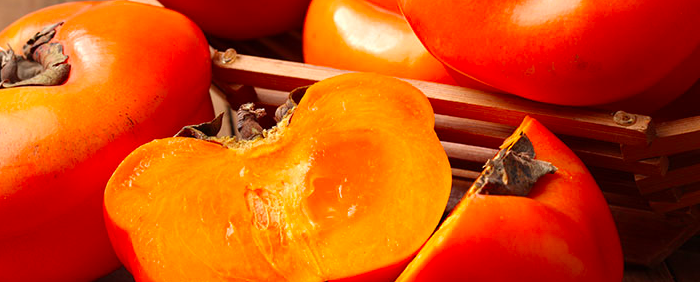
Persimmon is the fruit of the persimmon tree belonging to the large family of hardwoods such as ebony. It is the only tree in this family to produce an edible fruit. Persimmon is the national fruit of Japan. It is also grown in China, Israel, Korea and the United States. There are hundreds of different varieties of persimmon but they can be classified into two main categories: Asian persimmon and American persimmon, a younger species. These fruits are available in autumn, from approximately September to December. Persimmons remain attached to the tree even after the leaves have fallen.
Characteristics of persimmon:
- Rich in antioxidants;
- Rich in vitamin C;
- Boosts the immune system;
- Contributes to good vision;
- Contributes to the good health of the skin.
What is persimmon?
Persimmon identity card
- Type: Fruit;
- Family: Ebénaceae;
- Origin: Japan;
- Season: October to January;
- Orange color ;
- Flavor: Tart or very sweet.
Characteristics of persimmon
When harvested, persimmon is a small, round fruit with smooth skin, the color varying from red to orange. An persimmon weighs between 150 and 400g on average.
Word from the nutritionist
Persimmon is a fruit that deserves to be added to our menu. As it is available for a very short period during the year, take the opportunity to refuel it during the fall. Freeze or dehydrate them, they will be available year round.
Nutritional values
Per 100g of raw persimmon:
| Nutrients | Quantities |
| Protein | 0.7g |
| Fat | 0.3g |
| Carbohydrates | 15.3 g |
| Water | 80.7 g |
| Fibers | 2.5g |
| Vitamin C | 7 mg |
| Vitamin E | 0.5 mg |
| Vitamin B9 | 22 µg |
| Potassium | 171 mg |
| Calcium | 21 mg |
| Phosphorus | 20 mg |
6 benefits of persimmon: why eat it?
- Persimmon, like most fruits, is rich in water which contributes to our daily water intake.
- The persimmon is rich in fiber which allows it to stimulate the intestinal transit and to play on satiety thus allowing to regulate the appetite.
- Persimmon is rich in vitamin C which helps fight fatigue, stimulate the immune system and fight against various infections and winter colds.
- Persimmon is very rich in antioxidants, especially in carotenoids responsible for its orange-red color. Antioxidants are compounds that protect the cells of the body from damage caused by free radicals. These are very reactive molecules which are implicated in the development of cardiovascular diseases, certain cancers and other diseases linked to aging.
- Persimmon is a source of folate. Folate (vitamin B9) is involved in the production of all cells in the body, including red blood cells. This vitamin plays an essential role in the production of genetic material (DNA, RNA), in the functioning of the nervous system and the immune system, as well as in the healing of wounds and wounds. As it is necessary for the production of new cells, adequate consumption is essential during periods of growth and for the development of the fetus.
- Persimmon is a source of manganese. Manganese acts as a cofactor for several enzymes that facilitate a dozen different metabolic processes. It also participates in the prevention of damage caused by free radicals.
Choose the right khaki
When purchasing, choose an intact fruit and avoid yellow or greenish persimmons, signs that they are not ripe.
The different varieties
There are hundreds of different varieties of persimmon but they can be classified into two main categories: Asian persimmon and American persimmon, a younger species.
The two most popular varieties from Asia are hachiya and fuyu which are the size of a tomato. The hachiya has a sweet and tender flesh and a thin, smooth orange-peel. It should be eaten when it is very ripe and very soft otherwise it is not edible. As for him, the fuyu can be consumed when it is still firm. This fruit contains inedible brown seeds to be removed before consuming it.
Keep well
If the purchased persimmon is not ripe, allow it to ripen at room temperature. It can also be put in a paper bag to speed up this process. Adding fruit that gives off ethylene like bananas or apples can speed up ripening even more. Ripe persimmon can be kept in the fridge for a few days. Otherwise, it can be frozen whole or mashed with lemon juice to prevent discoloration.
Preparation of persimmon
How to cook it? How to match it?
The fruit can be eaten plain by the spoon. Fuyu can be crunched like an apple. It can also be mashed (with a little lemon juice) and served over ice cream, cake or a pancake. Otherwise, it can also decorate fruit salads, rice, seafood or poultry. It can accompany cheese and can also flavor yogurt or flans. Finally, the persimmon can be cooked to make a jam, dehydrated or canned.
History of persimmon
The culture of persimmon dates back to Neolithic times in Japan and China. It developed in Europe from the end of the XIXth century due to the arrival of the influence of Japan. It is now cultivated around the world, both in Brazil and in Lebanon via the south of France